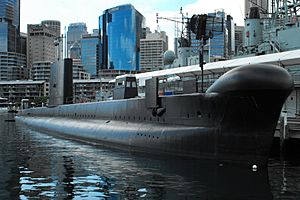HMAS Onslow facts for kids
class="infobox " style="float: right; clear: right; width: 315px; border-spacing: 2px; text-align: left; font-size: 90%;"
| colspan="2" style="text-align: center; font-size: 90%; line-height: 1.5em;" | 
|} HMAS Onslow (SS 60/SSG 60) was a special submarine that served in the Royal Australian Navy (RAN). It was one of six Oberon-class submarines. The submarine got its name from the town of Onslow, Western Australia. It was also named after Sir Alexander Onslow. The submarine's motto, Festina Lente, means "Hasten Slowly." This motto and its special badge came from Onslow's family history.
Onslow was ordered in 1963. It was built in Scotland by Scotts Shipbuilding and Engineering Company. The submarine was started in late 1967 and launched almost a year later. It officially joined the RAN at the end of 1969.
Contents
| History | |
|---|---|
| Namesake | Town of Onslow, Western Australia |
| Ordered | 1963 |
| Builder | Scotts Shipbuilding and Engineering Company, Greenock |
| Laid down | 4 December 1967 |
| Launched | 3 December 1968 |
| Commissioned | 22 December 1969 |
| Decommissioned | 29 March 1999 |
| Refit | Modernisation (1982–1984) |
| Homeport | HMAS Platypus Sydney |
| Motto | Festina Lente ("Hasten Slowly") |
| Status | Museum ship at the Australian National Maritime Museum |
| General characteristics | |
| Class and type | Oberon-class submarine |
| Displacement |
|
| Length | 295.2 ft (90.0 m) |
| Beam | 26.5 ft (8.1 m) |
| Draught | 18 ft (5.5 m) |
| Propulsion |
|
| Speed |
|
| Range | 9,000 nautical miles (17,000 km; 10,000 mi) at 12 knots (22 km/h; 14 mph) |
| Test depth | 200 metres (660 ft) |
| Complement |
|
| Sensors and processing systems |
|
| Armament |
|
| Notes | Taken from: |
Life as a Submarine
Even though Onslow was never in a real war, it had some important events during its time in service.
Important Moments
In 1972, an incident happened when a sailor did not follow orders. This caused the submarine to dive much deeper than it was supposed to. After this, the Royal Australian Navy Submarine Service changed its rules. From then on, sailors had to volunteer to serve on submarines. They could no longer be simply assigned to them.
Another serious event happened in 1981. Fumes from one of the diesel engines filled the submarine. Sadly, one sailor died. After this, the Navy made changes to how submarines operate to keep everyone safer.
In 1995, there was a special ceremony called a line-crossing ceremony. This event led to new rules for how such ceremonies could be held on Navy ships.
Submarine Achievements
During its career, Onslow was the first regular submarine to be fitted with special missiles that could attack other ships. It was very good at practice battles, also known as wargames.
For example, in 1980, during an exercise called Kangaroo 3, Onslow successfully "sank" a group of seven ships! Later, in 1998, during a big exercise called RIMPAC, it even "sank" a huge United States aircraft carrier, the USS Carl Vinson. This showed how skilled the crew and the submarine were.
From Sea to Museum
Onslow finished its service in 1999. After that, it was given to the Australian National Maritime Museum. Today, you can visit Onslow at the museum. It is kept there as a museum ship, so people can learn about submarines and the Navy.
Images for kids
-
Onslow at the Australian National Maritime Museum, alongside the destroyer HMAS Vampire and the HM Bark Endeavour replica
-
HMAS Onslow on display at the Australian National Maritime Museum in 2017










